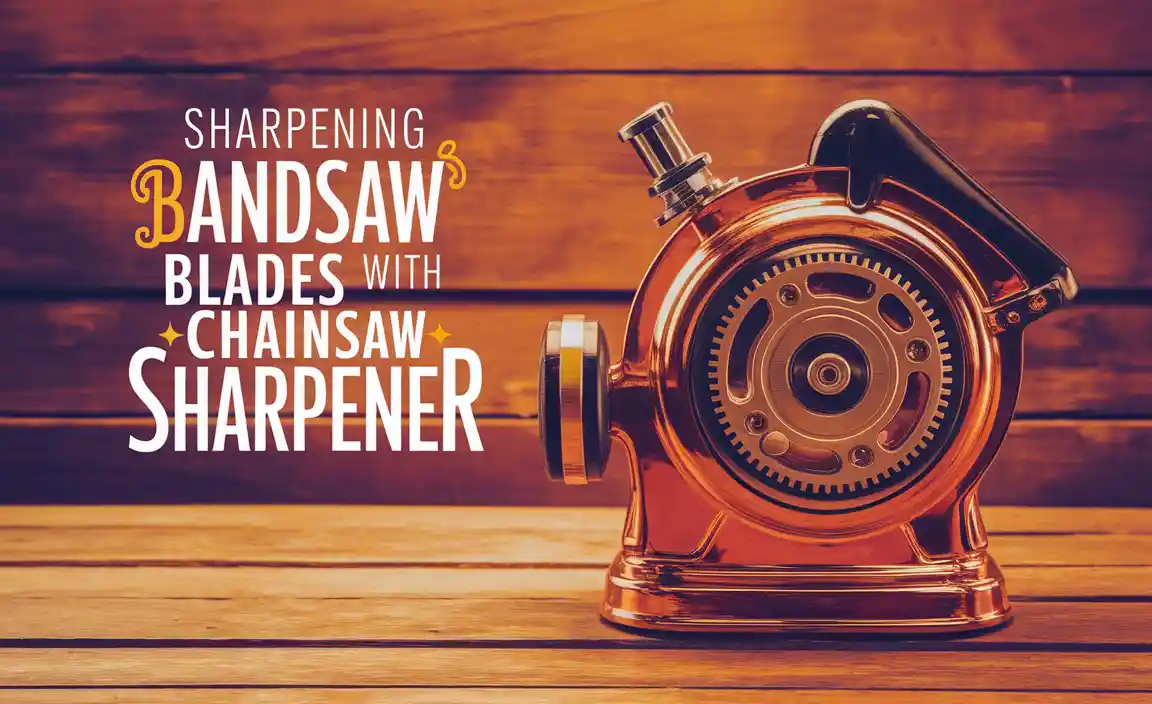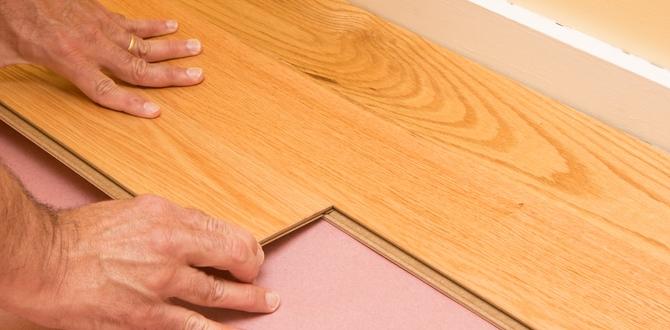To effectively use depth control on your nail gun, adjust the setting before each use to ensure nails are driven flush with the surface or slightly countersunk, preventing damage to your material and ensuring a professional finish.
When you’re working on a DIY project, the last thing you want is a nail sticking out too far or sinking too deep. It can look messy and even cause problems later on. Many nail guns have a special feature called “depth control” that lets you set how far the nails are driven. It sounds simple, but getting it right makes a big difference in how your project turns out. If you’ve ever felt frustrated by nails that don’t sit perfectly, you’re not alone. This guide is here to help! We’ll walk through how depth control works and how to use it like a pro, ensuring every nail is driven just right. Let’s get those projects looking sharp!
Table of Contents
Understanding Nail Gun Depth Control
Think of depth control as the fine-tuning knob for your nail gun. It gives you the power to decide exactly how deep each nail goes into the wood. This isn’t just about looks; it’s also about functionality and the integrity of your work.
Why Depth Control Matters
Getting the nail depth right offers several key benefits:
Aesthetic Appeal: For visible projects like trim or furniture, precisely set nails create a clean, professional look. You can choose to have them sit perfectly flush with the surface or be slightly countersunk (meaning they are just below the surface), ready for a little filler and paint.
Material Integrity: Driving nails too deep can split thin wood or damage your material. Conversely, nails that don’t go deep enough won’t hold securely, compromising the strength of your project. Proper depth control prevents both issues.
Surface Preparation: When you plan to fill nail holes and paint or stain your project, setting the nails just right makes the finishing process much smoother. A nail head that’s too high is hard to cover, and one that’s sunk too deep might create a weak spot or require excessive filler.
Efficiency: Once you dial in the correct depth, you can work faster without constantly stopping to check if each nail is driven properly. This saves time and reduces frustration.
How Depth Control Works (The Basics)
Most modern nail guns use an adjustable collar or a dial, usually located near the nose of the gun. You’ll typically see markings or numbers on this adjustment mechanism. Turning it in one direction drives the nails deeper, and turning it in the other direction makes them sit shallower.
The mechanism behind this adjustment often involves changing the pressure applied to the piston inside the nail gun. More pressure generally means the piston strikes harder and drives the nail deeper. Less pressure results in a shallower drive. Some advanced models might use electronic controls, but the principle remains the same: you’re controlling the impact force that drives the nail.
Types of Nail Gun Depth Control Adjustments
Nail guns come with different ways to adjust depth, and knowing your type is the first step to mastering it.
Manual Adjustment Dials/Collars
This is the most common type. You’ll find a rotating ring or a small knob, often with click-stops or detents, located near where the nails are fired.
How to use: You simply rotate the dial. Usually, there are visual cues like a plus (+) or minus (-) sign, or numbers indicating shallow to deep. Turning the dial might involve pressing a button or just twisting it directly.
Pros: Simple, often robust, and easy to understand.
Cons: Might require more trial and error to find the perfect setting, especially without clear markings.
Tool-Less Depth Adjustment
Some newer or higher-end models feature tool-less adjustments. This is often integrated into the gun’s base or a more prominent dial.
How to use: These are designed for quick changes. You might just lift a lever and rotate a dial, or press a button and turn a wheel. The changes are usually more precise.
Pros: Very quick and easy to adjust on the fly, often more precise.
Cons: Can be slightly more complex to figure out initially, and sometimes these mechanisms can be more prone to dirt or debris.
Electronic Depth Control
Found on some premium cordless or pneumatic models, these use electronics to manage the depth.
How to use: Typically involves pressing buttons on a small digital display or interface on the nail gun itself to select different depth settings.
Pros: Highly precise, repeatable settings, and easy to see the exact depth selected.
Cons: Can add to the cost of the tool and introduce electronic components that could potentially fail.
How to Use Depth Control: A Step-by-Step Guide
Using depth control effectively is all about preparation and testing. Don’t just guess and start firing nails! Follow these steps for nailing perfection.
Step 1: Identify Your Nail Gun’s Depth Adjustment
Before you do anything else, pull out your nail gun’s manual. If you don’t have it, a quick search online for your model number should bring up a digital copy. Familiarize yourself with where the depth adjustment is located and how it operates. Look for any markings that indicate adjustments for “flush,” “countersunk,” or numerical settings.
Step 2: Select Your Material and Fastener
The type of wood you’re working with and the size of the nails you’re using will significantly affect how deep the nail penetrates.
Hardwoods vs. Softwoods: Hardwoods like oak or maple are dense and require more power or a deeper setting to sink nails fully. Softwoods like pine are easy to penetrate, so you’ll likely need a shallower setting to avoid over-driving.
Nail Gauge: Thicker nails (lower gauge numbers) require more force.
Material Thickness: Obviously, a 1/2-inch piece of plywood will react differently than a 2-inch thick framing stud.
Step 3: Set Your Depth Adjustment to a Starting Point
Based on your material and desired outcome, set the depth control to a mid-range setting. If you’re new to this, a good starting point for most general carpentry tasks (like framing or trim work on standard pine) is often about one-third of the way between the shallowest and deepest settings.
For flush finish: You want the head of the nail to be level with the surface of the wood.
For countersunk finish: You want the head of the nail to be slightly below the surface, usually just deep enough to be hidden by a thin skim of wood filler or putty.
Step 4: Perform a Test Drive
This is the most crucial step! Never start on your actual project. Find a scrap piece of the exact same material you’ll be using.
Fire a Nail: Hold the nail gun firmly against the scrap wood and pull the trigger to fire one nail.
Inspect the Result: Carefully examine how deep the nail went.
Too proud (sticking out)? Adjust the depth control to a deeper setting.
Sunk too deep (making a large hole or splitting wood)? Adjust the depth control to a shallower setting.
Perfectly flush or countersunk? You’ve found your spot!
Step 5: Fine-Tune as Needed
Continue firing nails and making small adjustments until you achieve the perfect depth. Even small turns of the adjustment dial can make a noticeable difference. It’s better to make several tiny adjustments than one big one.
Tip: If you’re working with very thin wood or delicate trim, be extra cautious. You might need to use the lowest possible setting and even consider using your nail gun on a lower air pressure setting if it’s pneumatic, to avoid damaging the material. Always consult your tool’s manual for specific recommendations on material types and settings.
Step 6: Work on Your Project
Once you’re confident with the depth setting on your scrap wood, you can start working on your actual project. Keep the nail gun pressed flush against the surface for consistent results.
Step 7: Re-evaluate and Adjust (If Necessary)
Throughout your project, you might encounter different wood densities or need to nail into different areas (e.g., nailing into a knot versus clear wood). If you notice inconsistency, don’t hesitate to pause and re-test your depth setting on a scrap piece. It only takes a moment and can save you from fixing errors later.
Factors Influencing Nail Depth
Several elements can affect how your nail gun drives nails, even with depth control. Understanding these will help you troubleshoot and achieve consistent results.
Air Pressure (for Pneumatic Nailers)
For pneumatic nailers, the air pressure from your compressor is a major player.
Higher Pressure: Generally results in harder impacts and deeper nail penetration.
Lower Pressure: Leads to softer impacts and shallower penetration.
The recommended air pressure range can usually be found in your nail gun’s manual. It’s essential to set your compressor’s regulator to the correct PSI. If your depth control seems inconsistent, check your air pressure and ensure it’s within the manufacturer’s specified range. An air pressure gauge on your regulator is a must-have. According to the Occupational Safety and Health Administration (OSHA), proper tool maintenance, including checking air hoses and connections, is crucial for safe and effective operation of pneumatic tools. You can find more information on pneumatic tool safety on the OSHA website.
Battery Power (for Cordless Nailers)
For battery-powered nailers, the charge level of your battery can sometimes influence the performance. While most modern battery tools are designed to maintain consistent power output, a nearly depleted battery might lead to slightly less powerful shots. Always ensure your battery is adequately charged before starting a large project.
Nail Gun Angle
This is a big one! If you don’t hold the nail gun perfectly perpendicular to the surface, the nail can be driven at an angle, causing it to sink less effectively or even miss the target material. Always aim to keep the nose of the nailer flush and straight against your workpiece.
Material Properties
As mentioned before, the type of wood is critical.
Knots: Nails will penetrate less effectively into knots due to the dense, hard nature of the wood in those areas.
Grain Direction: Nailing with the grain can sometimes lead to less holding power compared to nailing across the grain.
Wood Moisture Content: Very wet wood can be softer and might allow nails to sink more easily, while extremely dry wood can be brittle and prone to splitting.
Nail Gun “Spitting” or “Pushing”
Sometimes, instead of driving the nail cleanly, the gun might push against the wood, leaving the nail head proud. This can be due to trying to drive a nail too deep for the settting, insufficient power (air pressure or battery), or hitting very hard material. Adjusting depth control or power source is key.
Table: Common Depth Control Scenarios & Solutions
Here’s a quick reference guide for common nail gun depth control issues you might encounter.
| Problem | Cause | Solution |
|---|---|---|
| Nails are too proud (sticking out). | Depth set too shallow. Insufficient air pressure (pneumatic). Low battery charge (cordless). |
Adjust depth control to a deeper setting. Increase air pressure. Use a fully charged battery. |
| Nails are sunk too deep. | Depth set too deep. Excessive air pressure. |
Adjust depth control to a shallower setting. Decrease air pressure. |
| Nails are splitting the wood. | Nails sunk too deep. Nailing into a knot or very dense area. Using too large a nail for the material. |
Adjust depth control to a shallower setting. Try a different spot or test depth on a consistent area. Use a smaller gauge nail. |
| Inconsistent depth across different pieces of wood. | Varying wood density/type. Incorrect air pressure. Nail gun not held perpendicular. |
Re-test depth on each new material type. Ensure consistent air pressure. Hold nail gun straight. |
| Nail gun isn’t driving nails at all. | Safety tip not depressed. Jammed nail magazine. Tool malfunction. No air pressure (pneumatic). Dead battery (cordless). |
Ensure safety tip is firmly against the wood. Clear any jammed nails. Troubleshoot tool per manual. Check air connection and compressor. Charge or replace battery. |
Tips for Different Materials
Your depth control settings might need to vary depending on what you’re nailing into.
Trim and Molding
When working with delicate trim, you want nails to be flush or slightly countersunk so they’re easy to fill and paint.
Recommendation: Start shallow. You can always sink a nail a bit deeper, but fixing a hole blown out by an over-driven nail is much harder. A common technique is to set the nail head just below the surface to leave room for wood filler without creating a dimple that shows through paint.
Framing Lumber
For structural work, you need nails to be driven securely to ensure the strength of the joint.
Recommendation: Aim for flush or slightly countersunk. The nail head should not be proud, but it doesn’t need to be deeply buried. Over-driving can sometimes weaken the wood around the nail, especially in softer woods. If you’re using framing nails (often 2.5-3.5 inches), ensuring they seat properly is key for structural integrity. The Fine Homebuilding guide offers great tips for various nailing applications.
Plywood and MDF
These materials can be prone to blow-out if nails are driven too aggressively or too deep.
Recommendation: Use a shallower setting than you might expect. Plywood layers can sometimes delaminate, and MDF can crumble. Aim for a nail that’s just proud enough to be visible, or very slightly countersunk, to avoid damaging the surface.
Hardwoods (Oak, Maple, etc.)
These dense woods require adequate power.
Recommendation: You’ll likely need a deeper setting and sufficient air pressure (if pneumatic) compared to softwoods. Test carefully, as nails that stop short can be a real nuisance in hardwood.
Common Mistakes to Avoid
Even with the best intentions, beginners can fall into a few common traps when using depth control.
Not Testing First
This is the number one mistake! Starting a project without testing your depth control on scrap material is a recipe for disaster. You’ll end up with a mix of over-driven and under-driven nails, requiring extra time for repairs.
Making Huge Adjustment Jumps
When fine-tuning, don’t crank the dial all the way from shallow to deep. Make small, incremental adjustments. It’s a process of refinement.
Forgetting Air Pressure/Battery Charge
Forgetting that air pressure or battery life can affect performance will lead to inconsistent results. Always ensure your power source is adequate and properly set. For pneumatic tools, a sudden drop in air pressure can mean nails start sticking out unexpectedly.
Nailing at an Angle
Not keeping the nail gun perpendicular to the surface is a common oversight. This can cause the nail to skim the surface or drive at an angle, weakening the hold and creating a visibly uneven result.
Not Re-testing When Materials Change
If you move from one type of wood to another, or even from clear wood to a knot within the same board, your previous setting might not hold true. Always be prepared to re-test and adjust.
Maintaining Your Nail Gun for Optimal Depth Control
A well-maintained nail gun will perform more reliably, and that includes its depth control.
Clean Regularly: Keep the nose of the nail gun clean. Dust and debris can interfere with the piston and depth adjustment mechanism.
Lubricate: Follow your manufacturer’s recommendations for lubrication. Pneumatic guns often require a few drops of specialized oil in the air inlet.
Inspect O-rings and Seals: Worn O-rings can lead to air leaks and inconsistent power, affecting nail depth.
Check the Safety Tip: Ensure the contact tip (the part that pushes down before firing) is not damaged or stuck. It needs to move freely for proper operation and safety.
Frequently Asked Questions (FAQ) About Nail Gun Depth Control
Here are answers to some common questions beginners have about using depth control on nail guns.
Q1: Can I adjust the depth on any nail gun?
A1: Most modern nail guns, especially finish nailers, framing nailers, and brad nailers, come equipped with some form of depth adjustment. However, some very basic or older models might not have this feature. Always check your tool’s specifications or manual.
Q2: What’s the difference between flush and countersunk nails?
A2: A flush nail means the nail head is perfectly level with the surface of your material. A countersunk nail means the nail head is driven slightly below the surface. Both are common settings depending on whether you plan to fill and finish the surface.
Q3: Do I need to adjust depth control differently for different nail sizes?
A3:



